Nydri Vliho, a bridge and the Ambracian Gulf
The bay of Vliho, a bay behind Nydri, kept us longer than planned. I can’t remember having so many quiet nights at anchor in a row without wind and waves during our entire trip. Restful, undisturbed sleep. We were able to switch off completely at night, and even my usual co-sleeping alarm mode came to rest.
Every now and then, a flotilla arrived and tried to turn this peaceful bay into a party zone, but that was always quickly stopped.
We took it very slowly, mainly because Ka was suffering from a pinched nerve that was literally getting on her last nerve. Fortunately, 15 km away in Lefkas, there was Physo Efstathios Nellis, who took care of the problem. One day we had to go out to sea to refill our fresh water tanks. Unfortunately, you can’t produce fresh water in Nydri Bay.
Like so many Greek places – even those with some tourism – the Ionian places manage to remain completely unpretentious. No comparison to the luxury locations of the Côte d’Azur or some of the chic islands in the Aegean. In Nydri, cocktails cost single digits and everything remains relaxed. You can have dinner for two for €50. In Nydri, you can also spend €150+, as there are restaurants with sophisticated cuisine, a rarity among the predominantly traditional Greek taverns.
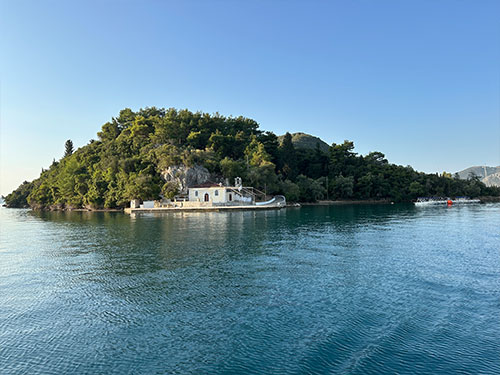
Leaving Nydri
I wonder if it will remain so wonderfully relaxed in this part of the world for much longer. More and more superyachts are calling at this region. They probably call it “still so natural”. But when Zuckerberg and his bros call at Zakynthos, it won’t be long before his social media cheerleaders attract the rest of the world and ‘naturalness’ becomes a thing of the past. Stay with your superyachts on the Costa Smeralda or in St. Tropez and let everything here take its slow course. Spoiler alarm: there is neither Gucci nor Prada here.
Talking about change: There is a very ambitious marina project for Vliho Bay that would destroy this wonderful bay. The plans have been in the works for a few years now, and if I’m not mistaken, 99.9% of people hope that it will never come to fruition.
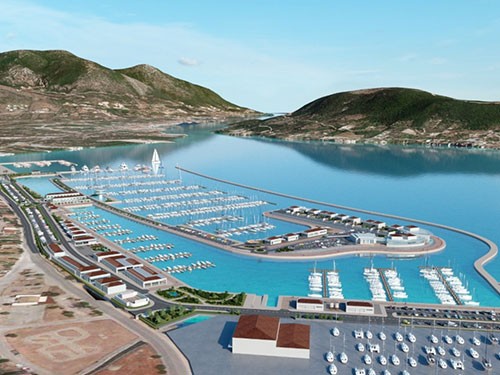
Vliho marina project
The Lefkada bridge is back
Well rested and ready to set off on our journey around western Lefkada, we received the news that a solution had been found for the Lefkada bridge. And indeed, exactly one month after it closed, a ferry was delivered from Athens.



Lefkada Kanal
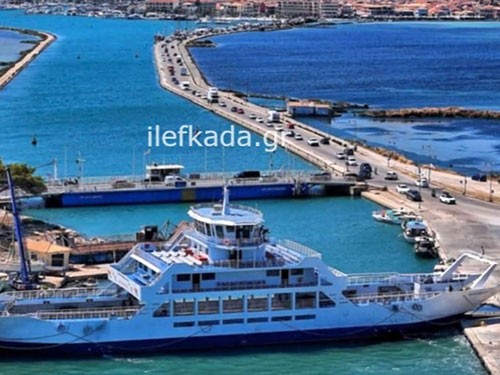
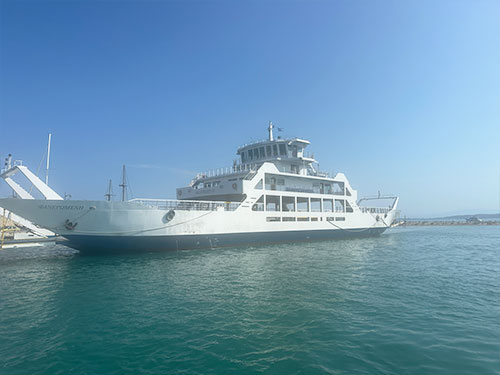
Online photo of the current ferry as a bridge, ‘bridge’ open. In the background is the old bridge, which has been removed.
A bizarre solution, because this ferry fit exactly into the canal with its ramps lowered. Car traffic, including coaches and trucks, drove lengthwise through the middle of the ferry to get from the mainland to the island. Six times a day, the captain started his engine and steered the ferry to the side so that vessels could pass through the canal. One can pour scorn on Greek bureaucracy for the licensing delay, but this solution was really creative and cool. It took exactly one month to solve the problem, respect.
F••• Social media
My deep aversion to (a)social media was reignited by this campaign. When the arrival of the ferry was reported objectively, posts from ‘experts’ immediately appeared, reporting complete nonsense. The ferry was too short, concrete work (exactly 20 m3 of concrete) still had to be done on the dock, and the opening would be postponed indefinitely. What goes on in the minds of these people? None of it was true. Nevertheless, dozens of comments were immediately posted, uncritically and without any knowledge, replying the same malicious and insulting statements.
It makes me feel quite queasy when I think about how many people rely on social media as their main source of information. Media in which every moron and self-important person can express their opinion. I would like to know how many sailors made their way north on the western route because of these false statements.
As announced, the ferry went into service on August 14 and our sailing buddies from the ‘Long Tom’ were the first customers. We set off the following morning. After 10 nm, we reached the canal at 9.50 a.m. and waited with 10 other vessels in the narrow fairway for it to open, with the same number on the north side. Easy and through. What a relief for Lekada and the whole community. Congrats guys, you made it happen.
On the north side of the canal, we set the jib in the light wind. Already during the first few miles, we remembered that we found the water in the northern part of the Ionian Sea clearer than in the south and especially in the east. It was super clear and clean, with no rubbish or visible plastic.
Prevaza anchorage
Our destination was Preveza, only 10 nm away. This small town with a population of 20,000 is located in the Ambracian Gulf, accessible from the Ionian Sea via a canal. It is another charter hotspot, with an airport, a large marina and incredible capacity for land storage for yachts.
We anchored next to the town in a well-protected bay for a few days. The muddy seabed provided good anchorage, but the water was murky and often dirty. The town is nice, pulsating to the rhythm of charter yacht handover dates and the sailing tourists arriving and departing with them. There are a many boutiques, taverns and bars, but very few shops for provisions. We had a few nice days and enjoyed delicious meals in the evenings at Mermaid Kaixis Restaurant, in the middle of the town’s narrow streets.

Kaixis Restaurant makes you happy
Ambracian Gulf
The Ambracian Gulf is a 400 km2 quasi-inland waterway, connected to the Ionian Sea only by the Preveza Canal. It is just under 20 nm long, approx. 14 nm wide and famous for its inhabitants: dolphins and turtles. There are also plenty of fish farms. At 29 degrees, the water is much warmer than ‘outside’, but not clear due to abundant nutrients and a mostly muddy seabed. Yachties have to ration their water, as we cannot make fresh water here.
The southern side of the gulf is greener than the northern side. Vonitsa was our next destination, a small village with 4,000 inhabitants. Despite a remarkable fortress and beautiful nature, Vonitsa is completely untouristy and nothing special. As a stranger, you are greeted warmly, and those who speak a foreign language usually ask if you like it here.
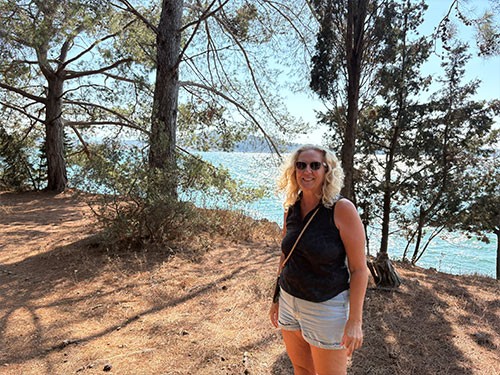
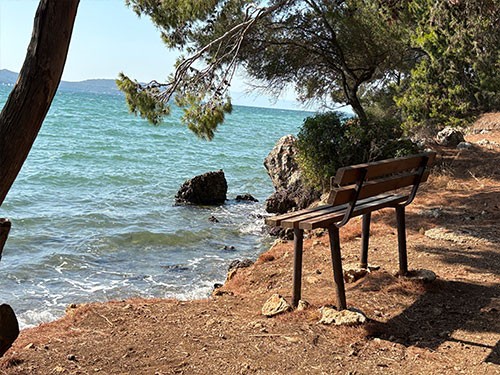
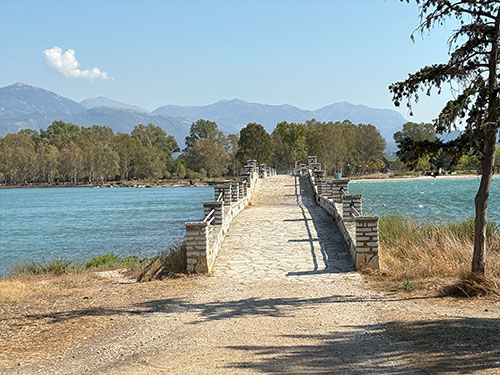
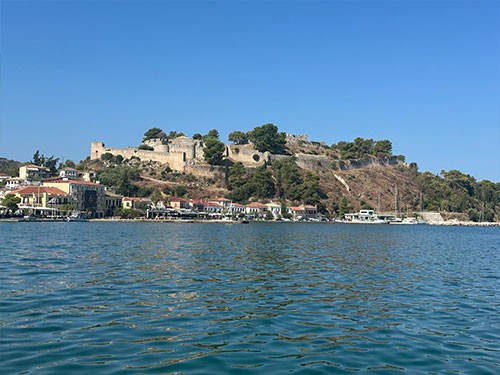
Our pine forest windbreak, with bridge and fortress of Vonitsa
We anchored in a bay east of the town, sheltered by a small romantic island with pine trees. To the east of our anchorage was an impressive mountain with a strange structure. A firefighter told us that a week before our arrival, a fire had raged here, almost completely burning down the mountain. Arson is suspected. Miraculously, the only house on the mountain survived the fire almost unscathed. As soon as the wind blew from the east, we smelled the remains of the fire – like clothes after an evening around the campfire.
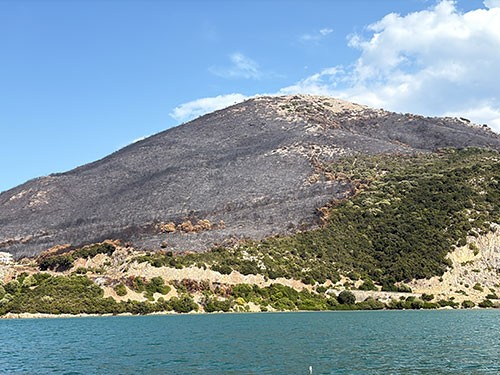

The entire mountain burned down, and this one house (far left in the photo) survived the inferno.
The Ambracian Gulf is a really good option for the high season. There are surprisingly few vessls around, and there are plenty of good anchorages. In the afternoon, usuailly between 2.30 and 6.30 pm, there is a fresh breeze for a good sail. This gulf is obviously not promoted by any of the charter fleets, so sailors remain among themselves and you hardly see any charter boat and definitely no flotillas.
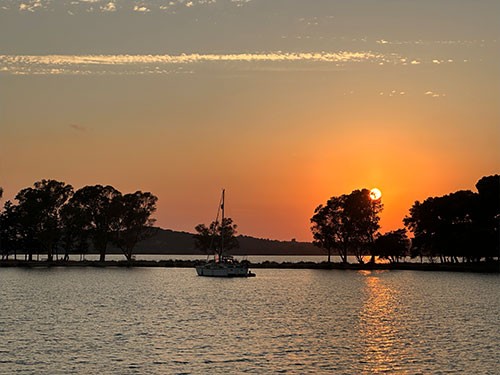
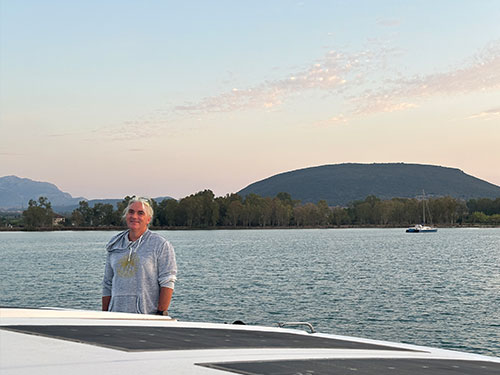

Our water supplies will determine how long we stay in this gulf. We won’t be able to refill the Rivercafe’s water tanks until we reach the Ionian Sea. /Holger Binz


Hallo Ihr Lieben,
Nur am Rande habt Ihr nun auch etwas von den unzähligen Bränden in Griechenland, Spanien, Portugal und Frankreich mitbekommen. Einen verkohlten Hügel.
Da könnt Ihr froh sein. Bei der Trockenheit bleiben solche Ereignisse nicht aus.
Nicht allein der Klimawandel ist schuldig.
Wir wünschen Euch, dass Ihr weiterhin von solchen Katastrophen verschont bleibt.
Auch gut, dass meistens viel Wasser um Euch herum ist.
Lieben Gruss aus der Eifel
Jürgen